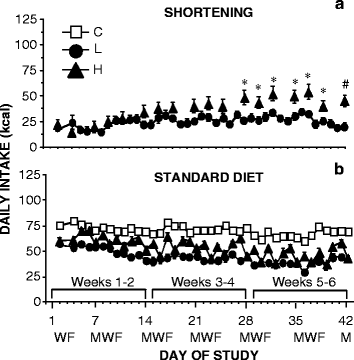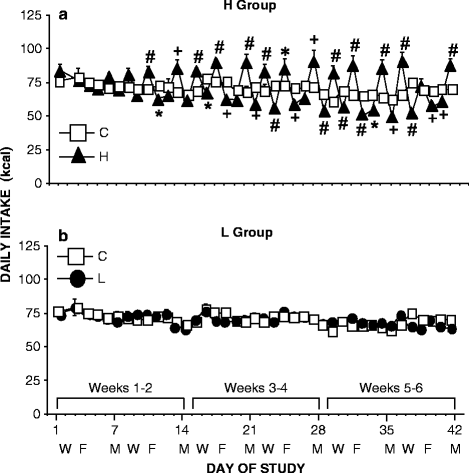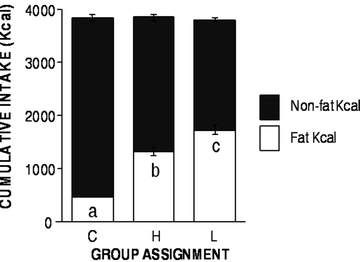Fig. 1.
Mean shortening intake during the 2-h access period. Bars represent mean shortening intake for the three 2-week periods of the study. Gray bars represent rats with Daily 2-h access to shortening (designated “L” for “low restriction” in this study); dark bars represent intermittent (INT) rats that had 2-h access to shortening on Monday, Wednesday, and Friday (MWF) (designated “H” for “high restriction” in this study). *p < 0.05; +p < 0.01. Vertical lines indicate SEM. Reproduced with permission from (27).

Fig. 2.
Effects of restricting access to shortening, without restricting access to the standard chow diet, on daily shortening (a) and standard chow diet (b) intake in male rats. Open squares represent chow controls “C.” The C rats had continuous access to the standard chow diet but no access to shortening. Closed circles represent rats with Daily 2-h access to shortening (designated “L” for “low restriction” in this study) and continuous access to the standard chow diet. Closed triangles represent INT rats that had 2-h access to shortening on MWF, and continuous access to the standard chow diet (designated “H” for “high restriction” in this study). Vertical lines indicate standard error of the mean (SEM). If no error bar is visible, then it is included in the symbol. (a) Shortening intake. Symbols indicate H > L: *p < 0.05; #p < 0.001. (b) Standard chow diet intake. Symbols indicating significance are not shown for clarity. L < C on all days (p < 0.001); H < C on all of the MWF shortening days (p < 0.05); H < C on 12 of the Tuesday, Thursday, Saturday, Sunday non-shortening days (p < 0.05). Reproduced with permission from (27).
3.2 24-h Chow Intake
Chow intake in the INT and Daily groups is generally less than that of rats that have continuous access to chow but no shortening access (Fig. 2b).
3.3 Total Energy Intake
Daily 24-h energy intake in the INT groups differs from that of chow-maintained controls on most days (Fig. 3a). On the days that shortening is provided, chow intake is not sufficiently reduced to compensate for the energy provided by the shortening. INT rats, therefore, consume more energy on shortening days than chow-only controls. However, on the days that shortening is not provided (Tuesdays, Thursdays, Saturdays, and Sundays, in the study shown), INT rats consume less energy than chow controls. The net result of this “overeat/undereat” pattern is that cumulative total energy intake across the study does not differ from that of chow controls (Fig. 4).



Fig. 3.
Effects of restricting access to shortening, without restricting access to the standard chow diet, on daily total energy intake in male rats. Group designations are as described for Fig. 2. (a) Total intake in the H (INT) group differed significantly from C (Chow controls). *p < 0.05, +p < 0.01, # p < 0.001. (b) Total intake in the L (Daily) group never differed from C. Reproduced with permission from (27).

Fig. 4.
Cumulative intake across the entire study. Total calories consumed did not differ among the groups; however, total fat increased as the fat became more available. Group designations are as in Fig. 2. Lower case letters indicate that the groups were different from each other (p < 0.05). Vertical lines indicate SEM. Reproduced with permission from (27).
In the Daily rats, daily 24-h energy intake does not differ from that of chow-only controls on most days (Fig. 3b). Thus, the cumulative total energy intake of the Daily rats also does not differ from that of chow controls (Fig. 4). Note that although total energy intake does not differ among the groups, cumulative energy from fat does. Specifically, even though the Daily group consumes less fat within the 1-h access period (Fig. 1), the Daily group usually consumes more cumulative fat over the course of a study than the INT group, because the Daily group has access to it 7 days per week.
3.4 Troubleshooting
3.4.1 Presence of Daily Group
The Daily group provides a standard against which bingeing in the INT group can be compared. It is essential that bingeing be compared to some control group that has access to the same optional food, for the same period of time, under similar circumstances, in order to clearly distinguish binge-type consumption from that which would normally occur in response to fatty and/or sugary foods. In addition, recent work indicates that the presence of the Daily group in the same room is critical for stimulation of progressive ratio responding in the INT group (manuscript in preparation), an effect possibly due to the introduction of uncertainty regarding when the shortening will be provided (40).
3.4.2 Failure to Sample the Shortening on Overnight Exposure
Seldom does a rat fail to sample the shortening on overnight exposure. When this occurs, we leave the jar of shortening in the cage for a full 24 h, which is usually enough time for the rat to start consuming the shortening. A rat that refuses to consume shortening after a full 24-h exposure is eliminated from the study.
3.4.3 Inability to Match Rats on More than One Variable
We have always been able to match the groups (up to four groups) by body weight, average 3-day chow intake, and overnight intake of shortening by first matching the overnight shortening intake. Once the groups are matched on one variable, the other variables generally fall into place. If not, a minimal amount of “tweaking” (switching a couple of rats among the groups) is required.
3.4.4 Failure to Consume Shortening During Limited Access Period
We occasionally get an animal that will consume only 0.1–0.3 g of shortening during the access periods in the first week. We have found that instead of putting the jar in the jar clip, putting the jar in the middle of the cage will engender greater amounts of consumption. Once the rat reliably consumes shortening, the jar can be put in the clip by the third week.
3.4.5 Chow Spillage/Shortening Hording
When measuring chow intake, paper towels are placed below the cage under the chow hopper outside the reach of the rat. It is necessary to make sure that the rat cannot reach the paper towel, lest you find a nest built in the cage the following day. It is also necessary to make sure that the cages near a door do not have enough change in air pressure to move the paper towel from its place when opening and closing the door. Spillage is placed into a weigh bowl by rubbing the paper towel together to make sure the entire spill is obtained. When removing the shortening from the cage after the access period, make sure to check under the cage and in the cage for balls/masses of shortening. Some rats have a propensity to scoop the shortening out of the jars. If an unusually large amount of shortening appears to be consumed, check the cage again by opening it and looking inside while the rat is moving. In a couple of studies, at least one rat would scoop out the shortening and then lie upon it, perhaps to “hide it from the investigator,” a strategy that is quite successful if the investigator is not vigilant.
3.4.6 Biting/Nipping
When using shortening as the optional food, rats will seldom bite or nip the fingers of the experimenter. When they do, it is usually when the shortening jar is removed from the cage. In a couple of studies one or two rats have actually jumped at the jar when being placed in the cage and became aggressive upon its removal. A clipboard placed between the rat and jar clip solves the problem.
When using sucrose as the optional food, either in liquid or semisolid form, rats seem to nip more often. With the liquid form, rats will nip for no apparent reason when filling chow hoppers or when the rats are being weighed. With the semisolid form of sucrose, rats will nip upon removal of the jar from the jar clip.
3.4.7 Eating at the End of the Access Period
Generally, all rats finish their consumption within 30 min and then retire to the back of the cage. Occasionally, one will encounter a rat that will resume eating when the jars are being pulled out of other cages. We generally pull the jar on this rat last as the duration of consumption is very short.
3.4.8 Fresh Versus Old Shortening
Jars are filled with fresh shortening weekly on the same day each week. Changing the shortening every session is both costly and unnecessary. We have been able to obtain consistent results throughout a week using shortening that was placed into the jars at the beginning of the week. We have used “old” shortening in a couple of pilot studies to save costs, only to find that the rats generally consume less if the shortening has remained in the jars for 2 weeks or longer.
3.4.9 Unanticipated Changes in Intake
Usually once or twice in an 8-week study, there will be a dramatic increase or decrease in optional food consumption on a particular day with a resumption of normal intakes the following day. We have no explanation for why this occurs.
3.4.10 Type of Limited Access
When rats are first exposed to the limited access procedure, it is critical that they be allowed to eat as much as desired within the limited access period. In short, it appears that they need to learn how to binge. In one study (24), we “clamped” intake by limiting the amount of shortening that rats with MWF and Daily 1-h access were allowed to consume during the first 5 weeks of the study. Results were then compared to rats with MWF and Daily access that were allowed to consume as much as desired during the 1-h access period. After 5 weeks, all groups were allowed to consume as much as desired during the 1-h access period for an additional 5 weeks. Binge size during the second 5-week period was reduced in rats with MWF access whose intake previously had been clamped, relative to the MWF rats that previously had been allowed to eat as much as desired. In contrast, intake in the previously clamped Daily rats was slightly increased (though not significantly so) relative to Daily rats that previously had been allowed to consume as much as desired. The net result was that the intake of the previously clamped MWF and Daily groups did not differ from each other, i.e., bingeing could not be assessed if only comparing these two groups. In contrast, the MWF and Daily groups that had not been clamped responded in our standard manner, i.e., MWF rats binged relative to Daily.
3.4.11 Hanging Cages Versus Shoe Box Cages
We use hanging wire cages for our studies rather than shoebox cages in order to more accurately measure food intake. Hanging cages allow for measurement of spill age, whereas shoebox cages do not. In addition, the bedding in the shoebox-type cages gets kicked into the shortening bowl, which introduces measurement error. Throughout the 20-plus years that we have been using hanging cages, health problems related to the cages have not been an issue.
3.4.12 Transfer of Rats to Clean Cages Mid-Study
Once rats are placed in their cages upon arrival at the vivarium, they should remain in those cages for the duration of the study. The one time we transferred rats into clean cages midway through a study, the intakes were altered (decreased) for over 10 days, but eventually recovered. We have never encountered any health problems with keeping rats in their original cages for the duration of a study.
3.4.13 “Enriched” Environment
Except for one pilot study, we have never examined the effects of enrichment on binge size. The results of the pilot study were inconclusive and hence, we have decided not to change our established protocol.
3.4.14 Temperature/Humidity
Large sudden shifts in outside temperature and/or humidity can significantly, but temporarily alter intakes. Large buildings generally have large heating/cooling systems that do not respond immediately or quickly enough to sudden changes in outside temperature. Additionally, air handlers for vivaria will draw in fresh air from the outside. One can expect a change in intakes for a couple of days in the spring and/or fall when there are sudden shifts in outside temperatures that the heating/cooling system is not able to accommodate. The altered intakes have always been temporary in nature. The temperature and humidity of the vivarium are also critical to obtaining consistent results. During one of our studies, the heating system malfunctioned causing the humidity in the vivarium to reach 70–84%. This resulted in significant decreases in both chow and optional food intake. We have found that a constant room temperature between 20.8 and 22.2°C and relative humidity between 37 and 45% are ideal to generate reliable intake of the optional foods.
3.4.15 Time of Day
As discussed above, the 12:12 light/dark cycle should be set prior to the arrival of the animals. The optional food should be provided 2.0–2.5 h prior to the dark cycle to allow the rats time to consume the optional food and the investigator to collect the data.
3.4.16 Binge Food: Use Something that Allows You to Distinguish the Groups
As mentioned above, it is critical that the optional food be one that allows intake differences to occur. If large (or small) intakes occur in both groups, bingeing cannot be distinguished from “normal” intake.
< div class='tao-gold-member'>
Only gold members can continue reading. Log In or Register to continue
Stay updated, free articles. Join our Telegram channel

Full access? Get Clinical Tree


